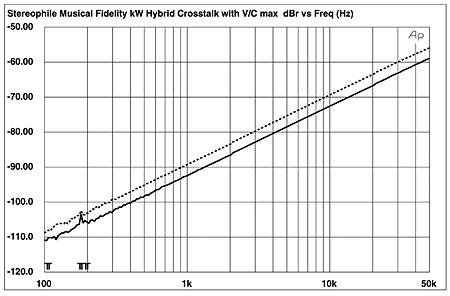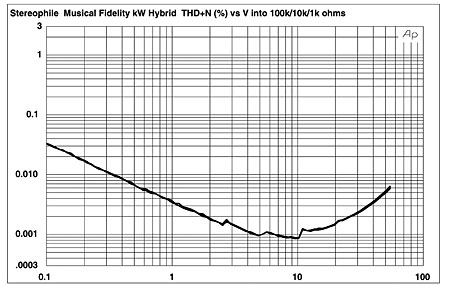| Columns Retired Columns & Blogs |
Musical Fidelity kW Hybrid line preamplifier & kW750 power amplifier kW Hybrid Measurements
Sidebar 3: kW Hybrid Measurements
The Musical Fidelity kW Hybrid preamplifier offered a sensible maximum gain of 12.5dB, this sourced from a very low impedance of less than 1 ohm across the audioband (including the impedance of 6' of interconnect). The preamp preserved absolute polarity. The input impedance was lower than specification at a moderately high 41.5k ohms at low and middle frequencies, dropping slightly to 36.5k ohms at 20kHz.
The Volume control demonstrated excellent channel matching at the top of its range, but at 12:00, where it would more likely be used, there was a channel imbalance of 0.4dB (fig.1). Note the extended ultrasonic response in this graph, which was not affected by the load impedance. However, the –3dB point did increase, from 126kHz to 162kHz, at the maximum setting of the Volume control, though this will have no subjective consequences. Channel separation was excellent at middle and low frequencies, but was degraded by capacitive coupling to an okay 65dB at 20kHz (fig.2).

Fig.1 Musical Fidelity kW Hybrid, Volume control at 12:00, frequency response at 1V into 100k ohms (0.5dB/vertical div.).

Fig.2 Musical Fidelity kW Hybrid, channel separation (R–L dashed, 10dB/vertical div.).
Noise levels were very low, even with the Volume control at its maximum—I measured an unweighted, wideband signal/noise ratio of 82.5dB ref. 1V output—but distortion was even lower. This was revealed by the linearly decreasing level of THD+noise below 10V output in fig.3. (Because the measured THD+N percentage is dominated by a constant level of background noise, it drops as a percentage as the output level increases.) Only at around 10V output level (!) does the distortion start to rise above the noise floor. You can see in this graph that the traces for 100k ohms, 10k ohms, and 1k ohm overlay each other. The Musical Fidelity's output stage is effectively immune to loading effects. Note also that the traces stop well short of clipping at an astonishing 54.7V output voltage, which is where my Audio Precision System One's signal generator reached its maximum output of 15V. The kW Hybrid has probably the highest dynamic-range capability of any preamplifier I have measured, more even than MF's own kWp.

Fig.3 Musical Fidelity kW Hybrid, distortion (%) vs 1kHz output voltage into (from bottom to top): 100k, 10k, and 1k ohms.
I plotted the percentage of THD+N against frequency in the preamp's output at a 10V output level (fig.4). The result hovers at the 0.001% level throughout the bass and midrange but begins to rise above 1kHz, reaching a still low 0.08% at 50kHz, due to the preamp's circuit running out of gain-bandwidth margin in this region. Note also that the traces for a 600 ohm load overlap those for 100k ohms, again showing that the kW's output stage is not fazed by low loads.

Fig.4 Musical Fidelity kW Hybrid, THD+N (%) vs frequency at (from bottom to top at 10kHz): 10V into 100k and 600 ohms.
The kW Hybrid offers extraordinarily low levels of distortion at the more modest output levels typical of those found in normal operation. Fig.5 shows a spectral analysis of the preamp's output while it drove a 1kHz tone at 1V into 8k ohms. The measured THD (true sum of the harmonics) was just 0.0004%! The only harmonics that can be seen are the third and fourth, lying at the residual level of my National Instruments signal generator; and the second, at –110dB, which is only just above the residual level. Intermodulation distortion was also very low (fig.6).

Fig.5 Musical Fidelity kW Hybrid, spectrum of 1kHz sinewave, DC–1kHz, at 1V into 8k ohms (linear frequency scale).

Fig.6 Musical Fidelity kW Hybrid, HF intermodulation spectrum, DC–24kHz, 19+20kHz at 1V into 8k ohms (linear frequency scale).
Regarding dynamic range, linearity, and the ability to drive low impedances, this is an extraordinary preamplifier.—John Atkinson
- Log in or register to post comments




































